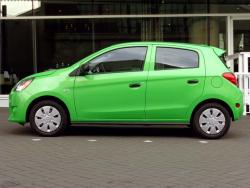 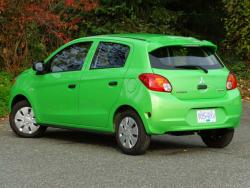 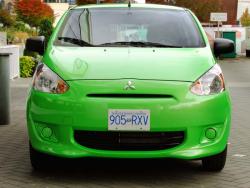 2014 Mitsubishi Mirage ES. Click image to enlarge |
Review and photos by Greg Wilson
Everybody loves a bargain, and on paper at least, the new Mitsubishi Mirage seems like a heck of a deal. Where else can you find a four-door, five-passenger hatchback with average fuel economy of less than 5.0 L/100 km that sells for under $13,000? With a base price of just $12,498 (plus $1,200 delivery charge), the Mirage ES is almost the cheapest car sold in Canada – it’s trumped by the ridiculously cheap $11,898 Nissan Versa 1.6 sedan.
Size-wise, the Mirage is bigger than a Smart Fortwo and smaller than a Toyota Yaris. Its closest competitor is probably the Chevrolet Spark: the Mirage is slightly longer and wider than the Spark but not quite as tall. But though it is small, the Mirage’s “wheels-at-each-corner” design and tall roof allows a surprising amount of cabin space and easy entry through four good-sized doors. And unlike the Spark, which seats only four people, the Mirage can seat five adults. However, the Mirage’s narrow body width means that the rear seat is better suited for two.
Powered by a 74-hp 1.2L three-cylinder motor and mated to a standard five-speed manual transmission or optional continuously variable transmission (CVT), the Mirage is officially rated at 5.9 city/4.6 hwy with the manual transmission (40/51 US mpg); and 5.3 city/4.4 hwy with the CVT (44/54 US mpg). (EPA ratings are 6.9/5.6 or 34/42 US mpg with a manual; CVT – 6.4/5.3 or 37/44 US mpg). That makes the Mirage even more fuel efficient than the tiny Smart Fortwo and Scion iQ. Only hybrids, plug-in hybrids (and electric cars) offer better fuel economy.
Vehicle manufacturers don’t often lend us base models with no options, so we were pleased to have the opportunity to test-drive a no-frills ES trim with the standard five-speed manual transmission. Finished in an eye-catching Kiwi Green exterior colour, we affectionately dubbed our tester, “Kermit”. Personally, I wouldn’t choose bright green, but when I ventured out into the daily chaos of urban traffic, I quickly realized that a bright colour is a great safety feature for a small car: nobody can miss you!
With just 74 horsepower at 6,000 rpm and maximum 74 lb-ft of torque at 4,000 rpm produced from its hard-working 1.2L DOHC 12-valve motor with variable valve timing, the Mirage is definitely a slowpoke – even though it only weighs 895 kg (1,973 lb). Recent AJAC performance tests clocked the Mirage with a CVT from 0 to 100 km/h in 13.2 seconds. That’s definitely slow, but the Chevy Spark is even slower: 0 to 100 km/h in 14.1 seconds!
The engine has so little torque that it’s necessary to downshift when ascending even the slightest grades. Passing on the freeway requires nerves of steel. Not only that, but the Mirage’s three-cylinder engine is noisy and coarse at higher revs, objecting strenuously at any attempt to approach its 6,600 rpm redline. At a steady cruising speed of 100 km/h, the engine turns over 3,000 rpm in fifth gear, higher than average, but necessary to compensate for the engine’s lack of torque.
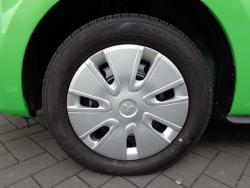 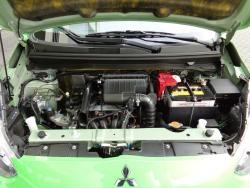 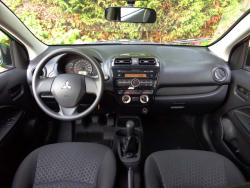 2014 Mitsubishi Mirage ES. Click image to enlarge |
The standard five-speed manual transmission is easy to shift and clutch pedal effort is light, but I found myself slipping the clutch in first gear in order not to stall the engine. The clutch engagement point is high and just touching the clutch pedal with the left foot begins to disengage it. It reminds me of the way cars used to be. One positive note: I was able to achieve around 5.3 L/100 km in city driving by shifting often and early, according to the onboard fuel consumption display.
I briefly drove the Mirage equipped with the CVT and though it is a bit slower than the manual car, it’s probably a better choice for the typical commuter.
At city speeds, the Mirage is a nimble handler – it has a traditional front MacPherson strut/rear torsion beam suspension – but because it is a narrow car with small skinny tires (Dunlop Enersave 165/65R14 all-season), it leans and understeers heavily when pushed to its limits (which aren’t very high). This is one car that could really benefit from its standard electronic stability control. In city driving, its tight turning circle of just 9.2 metres (30.2 ft.) makes it easy to park and maneuver in tight spaces and its electric power rack and pinion steering requires little effort.











